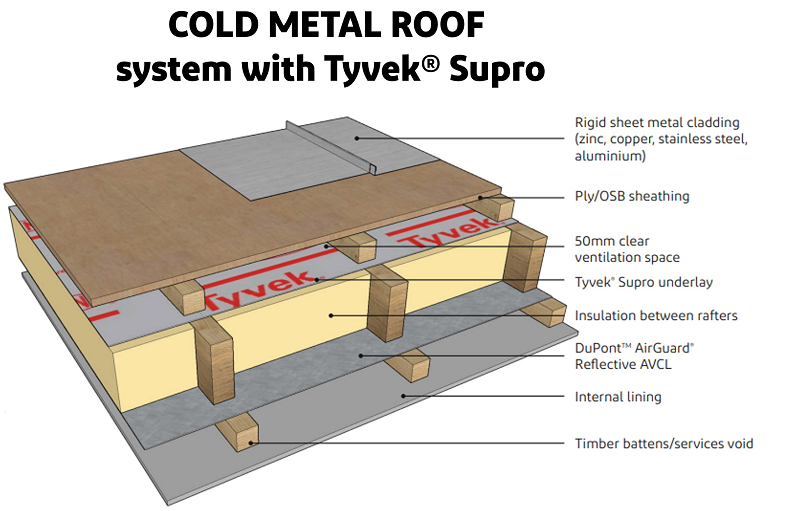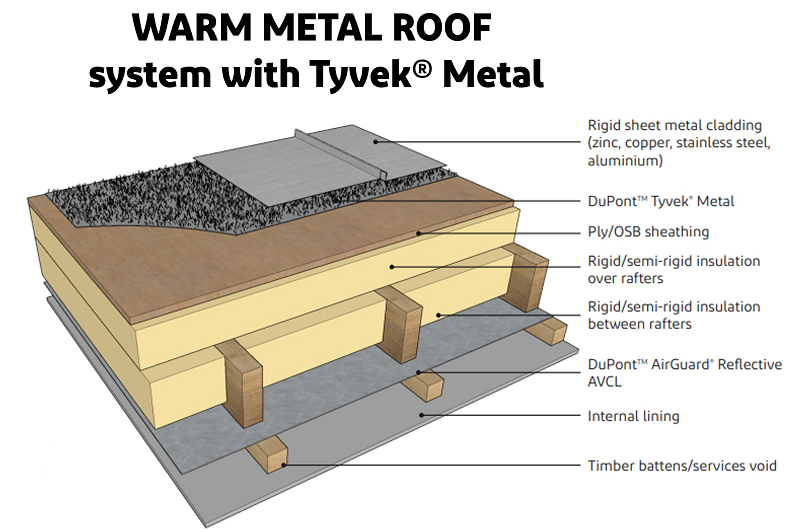<p style="text-shadow: 2px 2px 5px rgba(0,0,0,1);">Metal Clad Roofing Solutions</p>
Addressing METAL ROOFING risks with DuPont™ Tyvek® and AirGuard® system solution
For metal roofing systems, DuPont™ Tyvek® and DuPont™ AirGuard® offer a suite of products, designed to control condensation and mitigate heat build-up.
Metal roofs are durable yet vulnerable to condensation beneath the surface. Their high vapour resistance requires effective moisture management and careful design to control condensation.


Addressing METAL ROOFING risks with Tyvek® Supro / Supro Plus and Tyvek® Metal
Tyvek® Supro and Supro Plus are essential in metal roofing for managing condensation and moisture control. Tyvek® Supro Plus improves wind resistance and airtightness, while Tyvek® Metal, in addition, facilitates drainage and reduces sound transmission from rain. All Tyvek® products offer Class W1 water resistance and high strength, effectively safeguarding against potential water damage.
Using Tyvek® products benefits stakeholders:
- Architects and Designers: Confidently design with DuPont™ Tyvek® membranes for high-performance, durable structures that meet modern design and environmental standards, backed by DuPont's unwavering commitment to quality, service and innovation.
- Builders and Roofers: Superior weather resistance, easy installation, and extensive technical support (during and after installation), ensuring durable, high-performance roofing solutions that enhance efficiency and maintain professional reputation.
- Building Owners: The membranes deliver energy savings and maintain insulation effectiveness, reducing heating costs, safeguarding long-term roofing integrity and avoiding potentially costly repairs or replacements.
Addressing METAL ROOFING risks with AirGuard® Products
In metal roofing, the AirGuard® range is crucial for moisture control and thermal performance. AirGuard® Control acts as a high-performance Air and Vapour Control Layer (AVCL), preventing moisture ingress from the interior and allowing safe moisture escape, reducing condensation risk. AirGuard® Reflective, in addition, enhances thermal efficiency by reflecting heat back into the building, addressing potential energy loss.
Incorporating AirGuard® improves energy efficiency and moisture management:
- Architects and Designers: Confidently design metal roofs with the DuPont™ AirGuard® products to maintain insulation efficiency and prevent moisture issues, while also providing protection against weathering and thermal movement, ultimately extending the buildings' lifespan.
- For Builders and Roofers: Delivering energy-efficient and durable roofing solutions enhances overall building performance and therefore leads to improved client satisfaction.
- For Building Owners: By minimizing the risks of condensation and moisture infiltration, these products lower the likelihood of future repair needs, resulting in long-term cost savings and reduced maintenance concerns.
Tyvek® Breather Membranes: Supro/Supro Plus
Tyvek® Supro is the market-leading breather membrane and is a water-resistant membrane suitable for all supported and unsupported pitched roof applications in commercial and residential buildings.
Tyvek® & AirGuard® Sealing Tapes
Tyvek® and AirGuard® sealing tapes and accessories are specifically designed to complement Tyvek® breather membranes and AirGuard® air and vapour control membranes. They help to seal the building envelope, offering optimal airtightness, energy efficiency, long-term performance and durability.
AirGuard®: Vapour Control Layer Solutions
An AirGuard® vapour control layer can significantly reduce heat loss and increase energy efficiency. By controlling heat transfer and reflecting heat inside the building, they help keep buildings cool in summer, and warm in winter.
